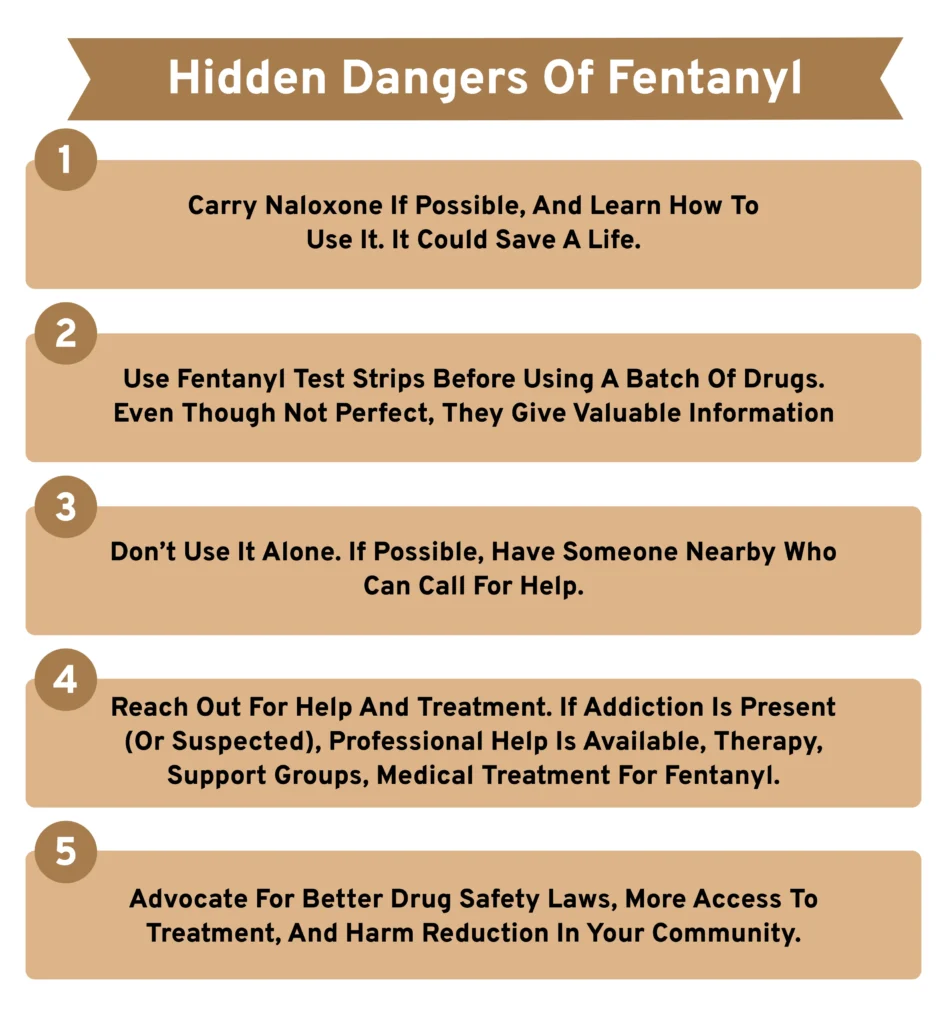Every time someone takes a street drug, there’s an unseen risk: it might be laced with fentanyl. Even a tiny amount of fentanyl can be deadly. Fentanyl is a synthetic opioid that is 50 to 100 times more potent than morphine, and what makes it especially dangerous is that many people don’t know it’s in the drug they are using.
Because of its potency, fentanyl can cause fatal overdoses in situations where someone expects a much weaker drug, or even in counterfeit pills. When the drug supply is unpredictable, someone might take what seems like a safe dose of a drug, only to be met with a lethal surprise. This article walks you through exactly why fentanyl shows up in street drugs, the risks, and what can be done to reduce harm.
Dangers of a Fentanyl Overdose
Fentanyl is very addictive once someone gets a taste of it, hence an overdose is a likely situation.
Respiratory depression is one of the dangers of Fentanyl and other strong opioids, slows down breathing. In an overdose, breathing can slow so much that the brain and body don’t get enough oxygen. That can permanently damage organs or lead to death.
Rapid onset & small margin for error is also possible because fentanyl is so powerful, even a small miscalculation in dose (or unawareness that a drug is laced) can lead to an overdose. What looks like a mild dose of something else can turn dangerous fast.
Mixed drug danger is when fentanyl is combined with other central nervous system depressants (like alcohol or benzodiazepines), or even with other opioids, the risk of overdose rises significantly. Tolerance (if someone has used opioids before) also matters. Periods without use (e.g. after detox or incarceration) make overdose risk much higher.
Unpredictability on the street, you can’t see, smell, or taste fentanyl. Drugs that look legitimate (prescription pills) might be counterfeit and lethal. Users often don’t expect fentanyl to be present.
What Is Drug Lacing
“Drug lacing” means adding a drug (or another substance) to a drug that someone else will consume, often without their knowledge. In this context, it means that fentanyl (or a fentanyl analog) is mixed into, or used to replace, some of the drug content. It might be done during manufacturing, transit, in illicit labs, or by dealers trying to stretch supply or increase potency. Because the illicit market is unregulated, there are no quality checks.
The result: a drug consumer has no idea of the true potency or contents.
Why Do People Lace Drugs (Possible Reasons)
Here are the main reasons dealers or producers might mix fentanyl into street drugs:
- Profit margin / cost savings:
Fentanyl is relatively cheap to manufacture (illicitly), and because it is so potent, a very small amount produces a strong effect. Dealers can mix it into other substances to mimic strength or to stretch their supply. - Counterfeit prescription drugs:
Fake pills made to look like prescription opioids (or even pills for anxiety, sleep, ADHD) often contain fentanyl. Buyers think they are safe because the pill looks legitimate. But counterfeit versions may carry lethal doses. - Unintentional contamination:
Sometimes cross-contamination in illicit labs happens. If tools or surfaces are used for fentanyl production and then used for other drugs, residues may end up in the final product. - Demand & user expectations:
In some markets, there is demand for more potent highs. Dealers respond by adding or substituting stronger substances. Also, as tolerance builds, users may seek stronger effects, pushing the market to supply more potent mixtures. - Trafficking & supply chain complexities:
Drugs may pass through many hands and have multiple adulterations. Illicit trafficking routes may involve mixing or cutting drugs to hide detection, to reduce weight/cost of transport, or to adapt to local demand.
Why Are Drugs Laced with Fentanyl
You might think this overlaps with the “why people lace drugs,” but here it’s more focused on the logic behind choosing fentanyl to lace drugs in particular:
Because fentanyl is extremely potent and a tiny amount can deliver a strong effect, it appeals to those who want to simulate higher cost or higher effect without using more of a bulkier (more expensive) substance. Plus, it’s hard to detect visually or by taste, you usually can’t tell if a drug is laced. So users are unaware, raising overdose risk. Dealers can market more “powerful” or “premium” versions of drugs without requiring much more raw material.
The rise of counterfeit pills makes fentanyl more attractive to users who believe they’re taking a prescription drug, while in reality they might be getting a lethal dose.
Fentanyl might be used to enhance or prolong effects, or to combine with other dangerous substances (sometimes intentionally, sometimes not) to produce a certain high.
Drugs That Might Be Laced With Fentanyl
Here are some common drugs found to be laced with fentanyl, sometimes intentionally, sometimes through contamination. This list is not exhaustive, but these are high-risk:
- Counterfeit prescription opioids (e.g. fake oxycodone, fake Percocet, fake prescription pain meds)
- Heroin
- Fentanyl-laced Marijuana
- Cocaine
- Methamphetamine
- MDMA / “ecstasy” / Molly
- Benzodiazepine lookalikes (counterfeit Xanax etc.)
- Sometimes stimulants that are sold as “party drugs”
- Occasionally counterfeit pills for non-opioid purposes (anxiety, ADHD, sleep)
Treatment and Prevention Strategies: Addressing the Root Cause of Addiction
It’s not enough to respond to overdoses, to truly reduce the risks, we need prevention, treatment, and systemic change. Here are some strategies, from community level in Rehab Centers to individual:
Treatment for substance use disorder (SUD)
- Medication-Assisted Treatment (MAT): Use of medications like buprenorphine, methadone, or naltrexone under medical supervision to reduce cravings, withdrawal, and risk of relapse.
- Counseling & behavioral therapies: Cognitive Behavioral Therapy (CBT), Motivational Interviewing, Community Reinforcement Approach, group therapy. These help people build coping skills, address underlying causes (trauma, mental health, social stress).
- Detox and inpatient/outpatient programs depending on severity.
Prevention and early intervention
- Education programs in schools, community centers to teach young people about risks of drugs, especially laced drugs.
- Early screening for substance misuse and mental health issues. Make help accessible before addiction worsens.
- Social support: stable housing, employment, peer support groups reduce risk.
Harm reduction measures
- Fentanyl test strips: allow users to test drugs for presence of fentanyl before using.
- Naloxone access / training: having naloxone (an overdose reversal drug) in public places, family or friends trained on how to use it.
- Safe consumption services where available, where people can use substances in supervised settings and get medical help fast if needed.
Policy & system‐level changes
- Decriminalization or public health models rather than criminal punishment. Makes users more likely to seek help without fear.
- Regulation of test strips and overdose reversal drugs so they are legal and accessible.
- Increased funding for addiction treatment, for public health outreach and for monitoring drug supply (e.g. detecting new analogs).
- Surveillance and data collection to detect dangerous trends early (new kinds of analogs, spikes in overdose).
Addressing root causes / social determinants
- Mental health care: trauma, depression, anxiety, stigma are often underlying drivers.
- Poverty, lack of opportunity, isolation: structural inequities often lead people toward drug use. Policies and programs that strengthen community, provide pathways out (jobs, education) help.
- Reducing stigma: people avoid seeking treatment if they fear judgment or legal consequences.

Precautions that You can take
If you or someone you care about is using street drugs, or you suspect a drug has been laced with fentanyl, there are things you can do now:
- Carry naloxone if possible, and learn how to use it. It could save a life.
- Use fentanyl test strips before using a batch of drugs. Even though not perfect, they give valuable information.
- Don’t use it alone. If possible, have someone nearby who can call for help.
- Reach out for help and treatment. If addiction is present (or suspected), professional help is available, therapy, support groups, medical treatment for fentanyl.
- Advocate for better drug safety laws, more access to treatment, and harm reduction in your community.
Struggling to find a safe place?
How can you tell if a drug has fentanyl in it?
You cannot see, smell, or taste fentanyl. The safest way is to use fentanyl test strips, which can detect many forms of fentanyl in a small sample. These strips are inexpensive and recommended by public health agencies.
Which drugs are most commonly laced with fentanyl?
Fentanyl is most often found in heroin, counterfeit prescription pills (like fake oxycodone or Xanax), cocaine, methamphetamine, MDMA, and sometimes even marijuana or party drugs. Always assume a drug might contain fentanyl unless it’s from a pharmacy.
What happens during a fentanyl overdose?
A fentanyl overdose usually causes very slow or stopped breathing, pinpoint pupils, cold or blue skin, and unresponsiveness. It can be fatal if not treated immediately. Naloxone (Narcan) can reverse the effects if given quickly.
How do you prevent a fentanyl overdose?
1. Test drugs with fentanyl test strips before use
2. Never use alone; have someone nearby
3. Start with a very small dose (“test dose”)
4. Carry naloxone and know how to use it
5. Seek help for addiction early treatment reduces risk
Can naloxone reverse fentanyl overdoses?
Yes. Naloxone is very effective, but because fentanyl is so strong, more than one dose might be needed. Call 911 and keep administering naloxone every 2–3 minutes until help arrives if symptoms don’t improve.
How long does fentanyl stay in your system?
Fentanyl can stay in the body for 8–24 hours depending on use, dose, and individual metabolism. In urine tests, it’s usually detectable for up to 3 days. For chronic users, traces may last longer.


